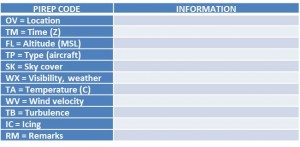Pipe Up with PIREPs
It’s a cold winter day in the Pacific Northwest, and you want to fly your single engine airplane from Boeing Field (KBFI) in Seattle to Bowers Field (KELN) in Ellensburg, Washington. You plan to fly Instrument Flight Rules (IFR), but there’s an overcast layer and you have to fly over the Cascades. You know that the freezing level is close to the 8,000 feet Mean Sea Level (MSL) minimum en route altitude (MEA) along the airway, Victor 2-298. So you know there is certainly potential for icing along your route, but you don’t know whether that potential translates to a problem, until you see the following pilot report (PIREP):
SMP UA /OV SEA090040 /TM 1824 /FL075 /TP C182 /WX FV99SM /TA 00 /TB NEG /IC NEG /RM EBND
As you see from reading the PIREP, a pilot flying an aircraft similar to yours, on the route you intend to fly and near your planned altitude, has given you an “all clear” by simply letting Air Traffic Control know that the aircraft has not encountered icing or turbulence along this route. Although you obviously have to evaluate the PIREP in the context of your entire weather briefing, this first-hand report from a fellow aviator may be the single most informative piece of data you have in that stack of “all available information” you got during your preflight planning process.
This report is a great example of how critical, and how valuable, a so-called “negative PIREP” can be. All too often, pilots – even those in the habit of offering PIREPs – tend to think they are valuable only when the weather is bad. Nothing could be further from the truth. Obviously, it is important to give a “here be dragons” warning when you encounter weather that your fellow pilots should avoid. Since we all love to fly, though, it is the duty of every good aviation citizen to be just as diligent in letting other pilots know when, and where, the air is clear of ice, turbulence, convective activity, and the many other weather dragons that can wreak havoc with your flight.
The negative icing/negative turbulence report from Stampede Pass is a also great example of success in Project PIREP, a 90-day demonstration project that the FAA, the Aircraft Owners and Pilots Association (AOPA)/Air Safety Foundation (ASF), and the National Weather Service (NWS) launched early in 2008 in an effort to generate more real-time pilot reports in the ice-prone skies of the Pacific Northwest.
Here’s how it worked in 2008 from January through April. During certain conditions or triggering events – such as known or forecast low ceilings, restrictions to visibility, mountain obscuration, and potential icing conditions – the NWS’s Aviation Weather Center (AWC) initiated the targeted PIREP request by having air traffic controllers in the Seattle Air Route Traffic Control Center (ARTCC) and surrounding TRACONs (Terminal Radar Approach Control), e.g., Portland, Spokane, Whidbey Island, and Chinook), specifically solicit at least three PIREPs every hour in multiple sectors. The goals of the demonstration project were to:
- Increase the quantity and quality of real-time weather reports from pilots.
- Focus the information collection process on the types of conditions and operations that lead to the largest segment of general aviation fatal accidents.
- Make this information available to: 1) Help the AWC more accurately identify areas conducive to airframe icing as well as areas of ice-free alternative routing; 2) Reduce the use of “VFR not recommended” advisories to pilots; and 3) Assist pilots in avoiding adverse weather conditions, including instrument meteorological conditions (IMC), icing, and convective activity.
If you’re curious about the results of Project PIREP, stay tuned. The organizations involved in this demonstration effort will review, summarize, and analyze the results in order to enhance the quantity, and quality, of PIREPs on a nationwide basis. But there’s no need to wait for Project PIREP in your area before you participate. Make it a point to help populate the system for your fellow pilots. Pipe up with PIREPs – including negative reports – on your next flight, and try to offer at least one PIREP on every flight you make.
How to Give P IREPs. If you’re not sure how to give a PIREP, or if the format you read in your weather briefing material seems too intimidating, make a table you can reproduce, attach to your kneeboard, and complete during your flight. For detailed information on reporting weather conditions and providing effective PIREPs, checkout the AOPA/Air Safety Foundation’s free online “Skyspotter” course. (FAA Aviation News MayJun 2008)
IREPs. If you’re not sure how to give a PIREP, or if the format you read in your weather briefing material seems too intimidating, make a table you can reproduce, attach to your kneeboard, and complete during your flight. For detailed information on reporting weather conditions and providing effective PIREPs, checkout the AOPA/Air Safety Foundation’s free online “Skyspotter” course. (FAA Aviation News MayJun 2008)
